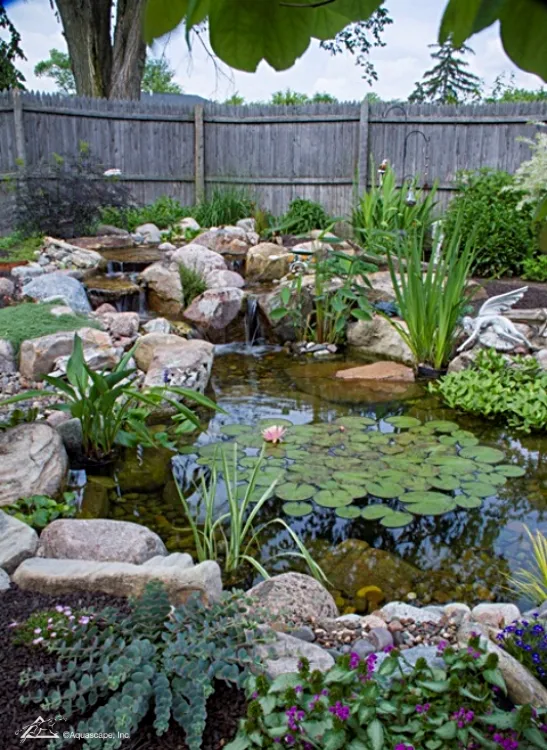Welcome to our guide on how to plant a pond! Creating a beautiful and thriving pond in your backyard can be a rewarding experience. Whether you are a beginner or an experienced gardener, this guide will provide you with step-by-step instructions on how to plant a pond that will enhance the beauty of your outdoor space.

Credit: www.aquascapeinc.com
Choosing the Right Location for Your Pond
The first step in planting a pond is choosing the right location. Select a spot in your yard that receives adequate sunlight for the plants to thrive. Make sure the area is not shaded by trees or structures that can block sunlight.
Consider the size of the pond you want to create and ensure that the location can accommodate it. Take into account factors such as accessibility, visibility, and proximity to water and power sources.
Preparing the Pond Site
Once you have chosen the location for your pond, it’s time to prepare the site. Start by marking the outline of the pond using a garden hose or spray paint. Dig out the area to the desired depth, making sure to create shelves for different types of aquatic plants.
Remove any rocks, roots, or debris from the site to create a clean and smooth surface for planting. Make sure the edges of the pond are level to prevent water from spilling over.
Installing the Pond Liner
After preparing the site, it’s time to install the pond liner. Choose a high-quality liner that is durable and puncture-resistant. Lay the liner in the pond and smooth out any wrinkles or folds to ensure a proper fit.
Secure the edges of the liner with rocks or soil to prevent it from shifting. Trim any excess liner, leaving a few inches of overlap to create a secure seal.

Credit: m.youtube.com
Adding Water and Filtration System
Once the liner is in place, fill the pond with water. Use a dechlorinator to remove any harmful chemicals from the water that can be harmful to aquatic plants. Install a filtration system to keep the water clean and clear.
Consider adding a pump to circulate the water and create a soothing sound of flowing water. Aeration is essential for the health of aquatic plants and fish in the pond.
Choosing Aquatic Plants
Now comes the fun part – choosing the aquatic plants for your pond! There are three main types of aquatic plants: oxygenating plants, floating plants, and marginal plants. Oxygenating plants help maintain water quality, floating plants provide shade and cover, while marginal plants add beauty to the pond’s edges.
Research the different types of aquatic plants that are suitable for your pond size and climate. Consider factors such as growth habits, water depth requirements, and maintenance needs when selecting plants for your pond.
Planting Aquatic Plants
When planting aquatic plants, consider the depth at which each plant should be placed in the pond. Oxygenating plants can be submerged at the bottom of the pond, while floating plants should be allowed to float freely on the surface.
For marginal plants, plant them along the edges of the pond in shallow water. Use a planting basket or aquatic soil to secure the plants in place and provide them with the necessary nutrients to grow and thrive.
Maintaining Your Pond
Once you have planted your pond, it’s important to maintain it regularly to ensure the health and beauty of the aquatic plants. Monitor the water quality, pH levels, and nutrient levels to prevent algae growth and maintain a balanced ecosystem.
Remove any dead or decaying plant material to prevent it from contaminating the water. Prune overgrown plants to maintain the desired aesthetic and prevent overcrowding in the pond.
Enjoying Your Pond
Now that you have successfully planted your pond, it’s time to sit back, relax, and enjoy the beauty of your outdoor oasis. Spend time by the pond, watching the fish swim and the plants bloom.
Consider adding decorative elements such as rocks, statues, or lighting to enhance the ambiance of your pond. Invite friends and family to enjoy your pond and create lasting memories in your outdoor space.
Conclusion
Planting a pond is a rewarding experience that allows you to create a tranquil and beautiful outdoor space. By following the steps outlined in this guide, you can plant a pond that will be a focal point in your yard and provide a habitat for aquatic plants and wildlife.
Remember to choose the right location, prepare the site properly, select the right plants, and maintain your pond regularly. With proper care and attention, your pond will flourish and bring joy and serenity to your outdoor living space.




